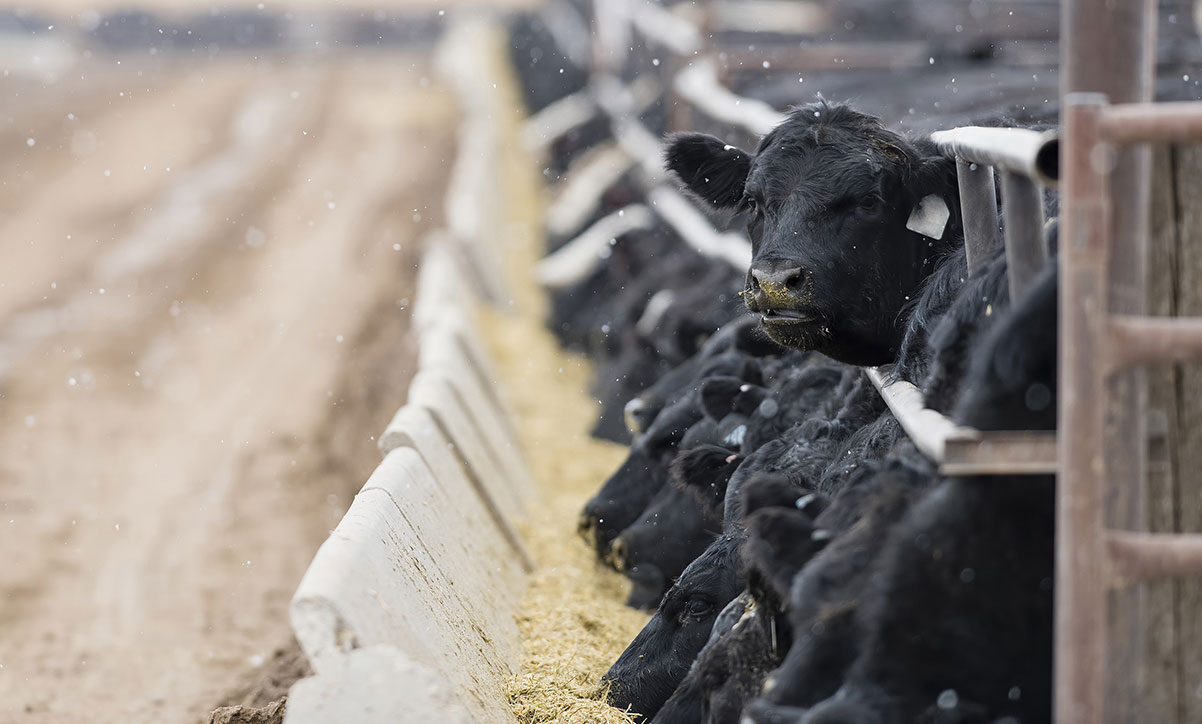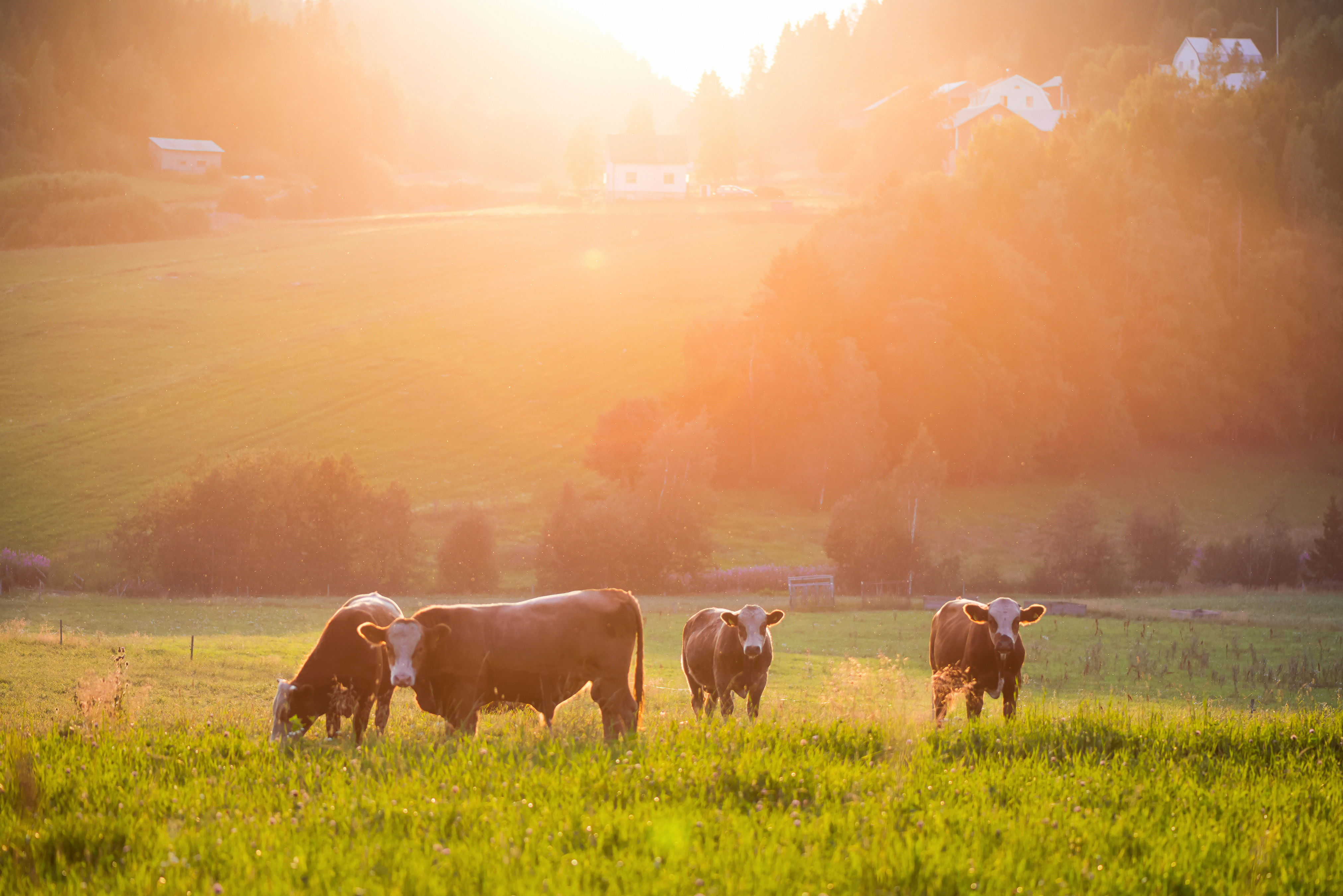Section 3 | Bovine Respiratory Disease in Feedlots
Page 15 /
Prevention of Bovine Respiratory Disease
Calves that develop BRD will not gain weight as well as their healthy herd mates. Thus, preventing BRD using management and vaccination strategies is the preferred approach to the control of this disease. Most BRD occurs within the first 21 days following arrival at feedlots or stocker operations. Therefore, the way that the animals are purchased and managed initially can have a significant impact on the occurrence of BRD.
Purchasing Practices
The purchasing strategy used for animals entering the feedlot can have a big impact on the level of BRD experienced. Specific factors to consider when purchasing calves include:
Entry weight
- Heavier cattle at arrival have a lower the risk of developing respiratory disease. Weight is often an indicator of age — heavier animals are likely older. Younger animals are more susceptible to pathogens as they have less immunity, experience more stress in transport, and can have a poorer response to treatment
Weaning
- Calves that are weaned for 45 days at the farm of origin prior to entry into a feedlot are at a lower risk of disease23. These calves have adjusted to being without their dams prior to the massive stressors of transport, mixing, and entry into the feedlot. Less stress enables them to better fend off disease

Bunk adjusted
- Bunk adjusted is a term used for cattle that have been fed grain in a bunk prior to being shipped to the feedlot. Calves that were previously fed grain at the farm of origin were found to be at a reduced risk of BRD24
Vaccination prior to purchase
- Calves that are vaccinated, specifically for bovine viral diarrhea virus or Mannheimia haemolytica, prior to purchase are at a lower risk of BRD
Castration and dehorning
- As both of these procedures are stressful, it is recommended to have these done prior to purchasing from the farm of origin
- Ensure that the farms you purchase calves from provide pain control during these procedures, as per the Code of Practice for the Care and Handling of Beef Cattle
- Cattle that are dehorned and/or castrated at the feedlot are at a higher risk of getting sick and dying
Calf source
- Purchasing cattle from sale barns leads to greater exposure to pathogens along with the increased stress of multiple transport events, marketing, and mixing with cattle from other farms. Thus, it is preferred to buy cattle directly from the farm or ranch of origin to eliminate these stresses25
Minimize stress
- After purchasing cattle, it is important to consider the impact that transportation has on future risk for BRD. Virtually all feedlot stockers will be transported, but the distance/time in transit and weather conditions need to be taken into consideration
- Try to avoid transporting cattle when sudden and extreme changes in weather are expected
- Long distances and time in transit will also lead to a higher risk of BRD
For more information on selecting only healthy calves for your farm, visit our Antimicrobial Stewardship in the Ontario Veal Industry section entitled: How to Select the Right Calf.

Management Practices at Arrival to the Feedlot
Mass Medication
The routine administration of antimicrobial medications to cattle at arrival to feedlots is a common practice, representing the largest quantity of antimicrobals used in the beef industry.
A recent review of over 150 studies found that the administration of injectable antimicrobials at arrival reduced the risk of BRD; however, the results were extremely variable depending on:
- The type of medication used
- The length of the trial
- The risk category of the calves
- The definition used for metaphylaxis
- Metaphylaxis is traditionally defined as the mass medication of a group of animals, in advance of an expected outbreak of disease
Despite this, the authors concluded that “the need for antimicrobial mass medications should be re-evaluated since the underlying problem is more likely the segmented infrastructure of the feedlot and cow-calf industries compared to the disease itself”26. It suggests that having improved purchasing practices and management of the newly arrived calves could lead to a significant reduction in disease, and therefore antimicrobial use.

Work with your veterinarian to develop a strategy tailored to the animals being brought into the feedlot. Calves could be categorized in risk groups where “high-risk” calves, such as those purchased from a sales barn, unweaned, after long durations of travel, and with low body weight receive an injectable antimicrobial at arrival. Low-risk calves, such as those that are weaned, have higher body weight, or are from a single source, could receive no injectable antimicrobial medication. It is not conclusively known if in-feed antimicrobial medications are effective at preventing BRD. Some studies say that it works, but most have found no effect25.
Vaccination
Vaccination for viral pathogens, and to a lesser extent bacterial pathogens, is an extremely common practice in cattle at arrival to the feedlot. Despite this, there is little evidence to support this practice. The presence of antibodies against pathogens causing BRD has been found to reduce the amount of disease. But vaccination does not consistently lead to protection, as the animal’s response to vaccination is highly variable.
Some of the reasons for vaccine failure include:
- Timing of administration
- Failure of stressed calves to respond to the vaccine
- Increased susceptibility of stressed animals to all pathogens
These limitations can be overcome by vaccinating calves prior to shipment to the feedlot. Additionally, sourcing preconditioned calves will ensure their response to vaccination is stronger and less variable. Work with your veterinarian to develop a vaccine program that works well for your farm. For more information on how vaccinations work, visit our Antimicrobial Stewardship FAAST Review section entitled: Vaccination as a Key Animal Health Tool.
Other Management Strategies
The management of newly arrived cattle can have an important impact on reducing the amount of BRD. It all comes down to reduced stress and providing a comfortable environment for stockers at arrival.
Some specific areas to consider include:
Introductory diet
- Diets for newly arrived cattle need to be formulated to adjust for low feed intake and allow stockers to become acclimatized to their new diet
Bunk space and stocking density
- Ensuring that the stockers have enough bunk space and stocking density will help to reduce the amount of stress they experience
Time to fill pen
- The time that it takes to completely fill a pen of cattle can also impact BRD. Taking longer than one day to fill a pen will lead to a higher risk of BRD. Constant mixing and establishing group dynamics can be problematic
Number of purchased groups per pen
- As the number of purchased groups of stockers per pen increases, the greater the risk of BRD. Groups with a higher level of commingling are at higher risk for BRD outbreaks
Bedding
- Having ample bedding is important, especially in the winter. This helps cattle stay warm and comfortable
For more information on making newly arrived calves more comfortable upon arrival to your farm, visit Key Aspects of Animal Husbandry as well as The Need for an Arrival Strategy page of our Antimicrobial Stewardship in the Ontario Veal Industry FAAST Review.

References
- Sanderson MW, Dargatz DA, Wagner BA. Risk factors for initial respiratory disease in United States’ feedlots based on producer-collected daily morbidity counts. Can. Vet. J. 2008;49(4):373-8.
- Hay, K.E., Morton, J.M., Clements, A.C., Mahony, T.J., and Barnes, T.S. 2016. Associations between feedlot management practices and bovine respiratory disease in Australian feedlot cattle. Prev. Vet. Med. 128:23-32
- Taylor JD, Fulton RW, Lehenbauer TW, Step DL, Confer AW. The epidemiology of bovine respiratory disease: What is the evidence for predisposing factors?. Can. Vet. J. 2010;51(10):1095-102.
- Baptiste, K.E., and Kyvsgaard, N.C. 2017. Do antimicrobial mass medications work? A systematic review and meta-analysis of randomised clinical trials investigating antimicrobial prophylaxis or metaphylaxis against naturally occurring bovine respiratory disease, Pathogens and Disease, 75(7):